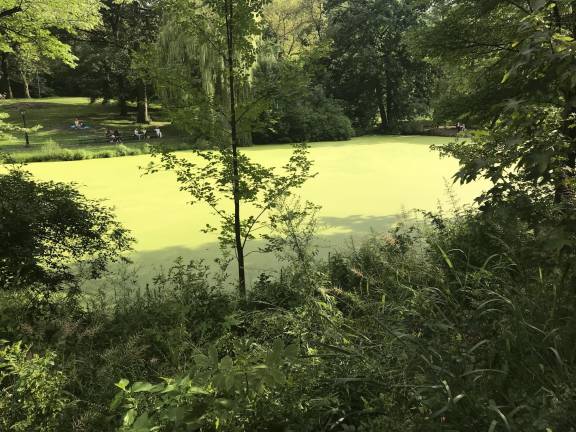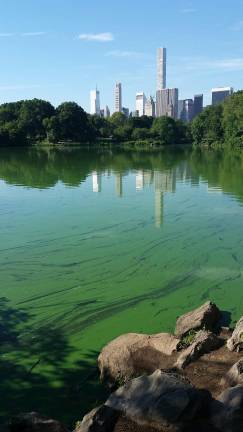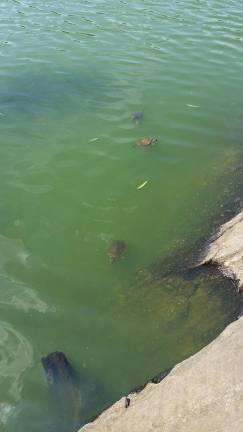The Green Gunk That Ate Central Park
Lakes, pools and ponds that are typically fresh, clean and crystal clear are now discolored or splotched. The culprit is blossoming algae – and it’s sometimes laced with toxins.
BY DOUGLAS FEIDEN
In all its magnificent shadings, the color green shimmers across the vast lawns and meadows and grassy banks and forest glades of Central Park.
Unfortunately, green also colors the sprawling, multi-acre algae blooms that are now blighting the park’s most beloved bodies of water.
Fast-growing algae accumulations have covered at least 18 locations in large swaths of four freshwater pools, ponds and lakes this summer, city and state data shows.
At least nine widespread algal blooms were spotted in the 20-acre Lake – one of them alongside the world-famous Bethesda Fountain – between May 19 and Aug. 12, according to monitoring by the city Parks Dept. and an analysis by the state Dept. of Environmental Conservation.
Of those nine, at least four were described as “Harmful Algae Blooms,” or HABs, by DEC, which uses visual observations, digital photographs and laboratory sampling results to make its determinations.
And of those four HABs in The Lake – a magnet for New Yorkers and tourists alike and the largest water body in the park after the Reservoir – two of them, including one in the romantic secluded oasis of Wagner Cove, were “confirmed with high toxins,” DEC found.
While most algae are harmless, playing a key role in healthy aquatic ecosystems, some species produce toxins that are potentially harmful to children and animals, and these HABs have been linked by scientists to the death of several dogs and other pets in North Carolina, Ohio and parts of New England.
Among the risks: Inhaling airborne water, droplets or spray can result in asthma-like symptoms. External contact can trigger a rash, itching or skin, nose, eye and throat irritations. And swallowing or ingesting the water can lead to nausea, vomiting, diarrhea, abdominal pain or other gastrointestinal symptoms, city and state officials say.
Don’t take any chances, the Parks Dept. warns. While blooms producing blue-green algae, technically called cyanobacteria, can be toxic, many aquatic plants that resemble it are harmless. But since it’s exceedingly tough for a lay person to discern the difference, park stewards say the safest recourse is simply for people and pets to steer clear of any visible blooms.
“When enjoying fresh water features in city parks, it is important to try to avoid contact with any algae, and keep pets on leashes, and do not allow them to enter or drink from lakes and ponds unless in areas specifically designated for such activities,” said city Parks spokesperson Megan Moriarty.
Whither the Red-Eared Slider?
How can you identify a potential bloom? That’s the easy part. Parks and DEC officials don’t typically deploy such colorful language, but they’ve variously described the unsightly mess as “carpet-like mats of floating green, bubbling pond scum” – and “green-tinted water” with “globs, clumps and/or dots” that has the appearance of pea soup, or green, blue or red paint.”
“Where did the turtles go?” asked 12-year-old Melinda Gross of the Flatbush section of Brooklyn, who was touring the Turtle Pond, parallel to West 80th Street, with a school group on a recent morning.
Actually, most of the five species who live there year-round were in residence. Still, in a body of water known for its purity and clarity and crystalline nature, the creatures, who love basking in the sun on flat logs or rocks, were very tough to find.
A volunteer descended on the pond, near Vista Rock, in an instant. She helpfully pointed out a couple of red-eared sliders. Melissa was grateful and overjoyed.
Still, she asked the obvious question: “Shouldn’t their home be a little bit cleaner?”
There was no ready answer. Eventually, the algae flushes itself out, dissipating when the chemistry balances.
At least four algae blooms were observed in Turtle Pond between July 21 and Aug. 12, and the HAB status was confirmed for three of them. All were described as “large in extent,” and one was identified as “widespread or lake-wide.”
The Role of Climate Change
It’s not wrong to factor climate change into the onslaught of algal blooms in Central Park: “Many factors influence algae blooms, including high nutrients, stagnant water, high temperatures and low oxygen,” Moriatry said.
Of course, cyanobacteria isn’t new, state scientists point out, and in fact, it has been present in waterbodies for thousands of years. So what is new? Many state officials believe climate change is a factor in the occurrence of HABs -- and the fact that reports of HABs are increasing worldwide supports that.
Meanwhile, according to Parks data and DEP photos and analyses, other park algae blooms include:
· At least four locations along the northeast shore of the Harlem Meer, at East 109th Street, all of which were observed between June 24 and Aug. 12. At least three were confirmed HABs, and one was described as “possessing high toxins.”
· At least one location in the Pool – photographed near West 101st by Straus News on Friday, Aug. 9th – and appearing to sprawl over the entire dimensions of the pool.
· Separately, outside of Central Park, at least two algae bloom sites in Morningside Pool in Morningside Park, near Morningside Avenue at West 103rd Street, were observed between July 7 and July 23. Both were described as small and localized, but both were also “confirmed HSBs.”
“Yuck!” said Courtney Browne, a nine-year-old Brooklyn schoolgirl as she stood on the north shoreline of The Pool on a recent afternoon with her parents. “... And I mean totally, totally yucky!”
invreporter@strausnews.com
“Yuck! ... And I mean totally, totally yucky!”
Courtney Browne, nine-year-old Brooklyn schoolgirl


